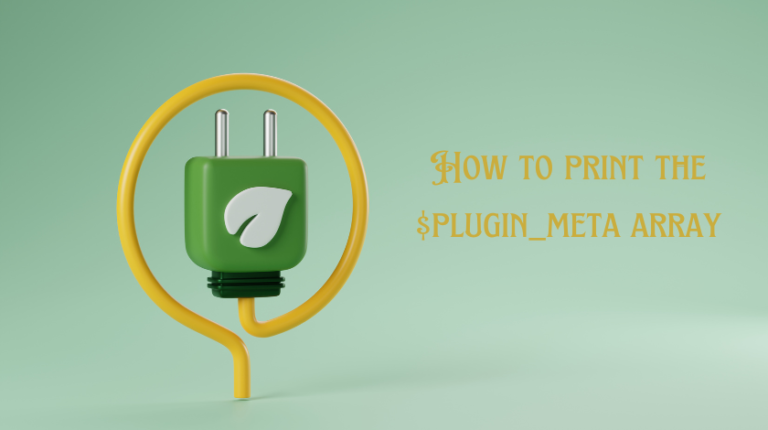Managing plugins efficiently in WordPress often requires a deep dive into their metadata. The $plugin_meta array is a powerful tool that developers can leverage to retrieve, analyze, and manipulate plugin information. In this article, we will provide a comprehensive guide on how to print and utilize the $plugin_meta array effectively in your WordPress environment how to print the $plugin_meta array.
By the end of this guide, you’ll have a thorough understanding of how to access and display this array for debugging, customization, or enhancement purposes. Let’s dive into the step-by-step process.
Understanding the $plugin_meta Array
The $plugin_meta array in WordPress contains metadata for plugins, including details such as version, author, description, and other critical information. This data is vital when working on custom functionalities or debugging plugin behaviors.
Where Does the $plugin_meta Array Come From?
The $plugin_meta array is often passed as a parameter to hooks or functions that interact with plugins. For instance, when you need to filter or display plugin data in the admin interface, you can tap into this array.
Setting Up to Access $plugin_meta
Before printing the $plugin_meta array, ensure you have the proper setup in your WordPress development environment. Here’s what you need:
- A WordPress Installation: Make sure you have access to the WordPress dashboard and file system.
- A Text Editor: Tools like Visual Studio Code or Sublime Text are ideal for editing PHP files.
- File Access Permissions: Ensure you have the necessary permissions to modify your theme or plugin files.
Step-by-Step Guide to Printing the $plugin_meta Array
Step 1: Hook Into the Right Action or Filter
The $plugin_meta array is accessible through WordPress hooks, such as plugin_row_meta. This hook allows developers to filter or append data to the plugin rows in the admin panel.
Here’s an example of how to use the plugin_row_meta hook:
Step 2: Add the Code to Your Plugin or Theme
Place the above code in your theme’s functions.php file or in a custom plugin file. This ensures that the code runs within the WordPress environment.
Detailed Explanation of the Code
1. The Hook
add_filter('plugin_row_meta', ...): This hook targets the how to print the $plugin_meta array meta information displayed in the plugins list table.- Priority is set to
10, and two arguments are passed:$plugin_metaand$plugin_file.
2. The Callback Function
The print_plugin_meta function receives the $plugin_meta array and outputs it using print_r. Wrapping it in <pre> tags ensures the data is displayed in a readable format.
Viewing the Printed $plugin_meta Array
After implementing the code:
- Navigate to the Plugins Page: In the WordPress admin dashboard, go to the “Plugins” section.
- Inspect the Output: The
$plugin_metaarray will appear on the plugin rows, showing all associated metadata.
Customizing the $plugin_meta Output
You can customize the $plugin_meta array to display additional information or append custom links. Here’s how:
This example appends a “Learn More” link to the plugin metadata.
Debugging Tips for $plugin_meta
- Enable WP_DEBUG: In your
wp-config.phpfile, setdefine('WP_DEBUG', true);to display PHP errors and warnings. - Use Error Logging: Instead of
print_r, log the output to a file for complex debugging scenarios: - Check for Conflicts: Disable other plugins temporarily to ensure your changes don’t conflict with existing functionality.
Use Cases for $plugin_meta
- Debugging Plugins: Quickly identify metadata discrepancies.
- Custom Dashboard Enhancements: Add custom links or notes to plugin rows.
- Auditing Plugin Data: Analyze the metadata for compatibility or performance.
Common Issues and Fixes
1. No Output Displayed
- Cause: The
plugin_row_metahook might not be firing. - Fix: Ensure the code is added to the appropriate file and that the hook priority is correct.
2. PHP Errors
- Cause: Syntax issues in the code.
- Fix: Use a PHP linter to check your code for errors.
3. Conflicts With Other Plugins
- Cause: Multiple plugins modifying the
$plugin_metaarray. - Fix: Use unique identifiers or namespaces in your functions to prevent overlaps.
Best Practices for Working with $plugin_meta
- Backup Your Site: Always create backups how to print the $plugin_meta array before modifying core files or plugins.
- Test in Staging: Use a staging environment to test changes before deploying to a live site.
- Follow WordPress Coding Standards: Ensure your code adheres to WordPress PHP standards for maintainability.
Conclusion
The $plugin_meta array is an invaluable resource for WordPress developers, offering insights and customization opportunities for plugin management. By leveraging hooks like plugin_row_meta, you can efficiently access and manipulate this data to enhance your WordPress site.
If you follow the steps outlined in this guide, you’ll be well-equipped to print, debug, and customize the $plugin_meta array in any WordPress project.
